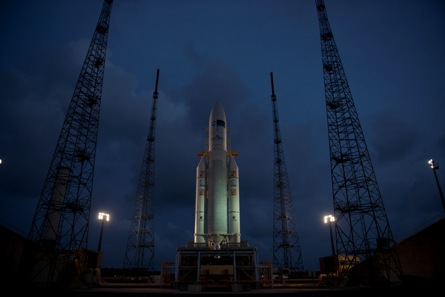A day after completing final assembly of the Ariane 5 rocket and its Automated Transfer Vehicle payload loaded with supplies for the International Space Station, the European Space Agency has decided to delay the scheduled 9 March launch, stating simply: "A routine inspection has concluded that additional measures are required to ensure the maximum readiness."
There is no indication so far of the possible extent of the delay, with ESA simply saying that a new launch date will be announced as soon as possible.
The 9 March slot sits in a relatively narrow window, given the amount of traffic coming and going from the ISS. ESA, for example, could not have delayed for many days the 13 February maiden flight of its new Vega light launcher, for fear of interfering with the ATV mission. ESA's Kourou, French Guiana space centre could cope with nearly simultaneous launches - the rockets fly from adjacent pads - but both missions need the same set of ground stations, including some shipboard receivers that need to be repositioned between the two flights.
Ariane 5's hiccup is not the only launch delay impacting ISS operations. Also this week it has emerged that ESA astronaut André Kuipers will stay on the Station for more than a month longer than originally planned owing to a delay in the launch of the next Soyuz crew ferry.
 |
|---|
©ESA |
Routine testing revealed problems in the original Soyuz spacecraft, requiring that it be replaced. The new date for Kuipers and his crewmates to return to Earth is 1 July - by which time he will have been on the Station for over six months. The Soyuz will leave the Station operating with only three crewmembers for a longer period than originally planned.
Ariane 5 marked its 46th consecutive successful launch during 2011, and the upcoming ISS mission will be the first of seven scheduled for 2012.
This third Automated Transfer Vehicle robotic supply ship - named Edoardo Amaldi after the late Italian physicist considered a pioneer of European spaceflight - is loaded with some 2.5t of dry cargo, water and oxygen, in addition to 5.4t of fuel to power itself and "re-boost" the Station to its full altitude. Another 860kg (1,900lb) of fuel will be carried for transfer to the Russian part of the Station.
ATV-3 will remain attached to the ISS until the end of August when, like its two predecessors, it will undock and de-orbit, burning up in the atmosphere.
Source: Flight International


























